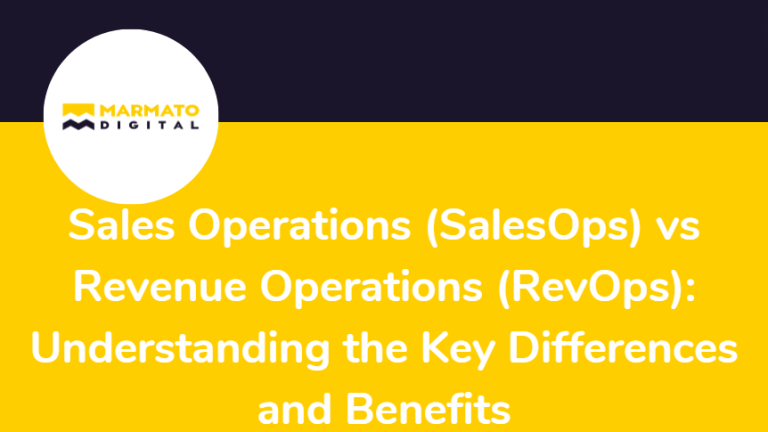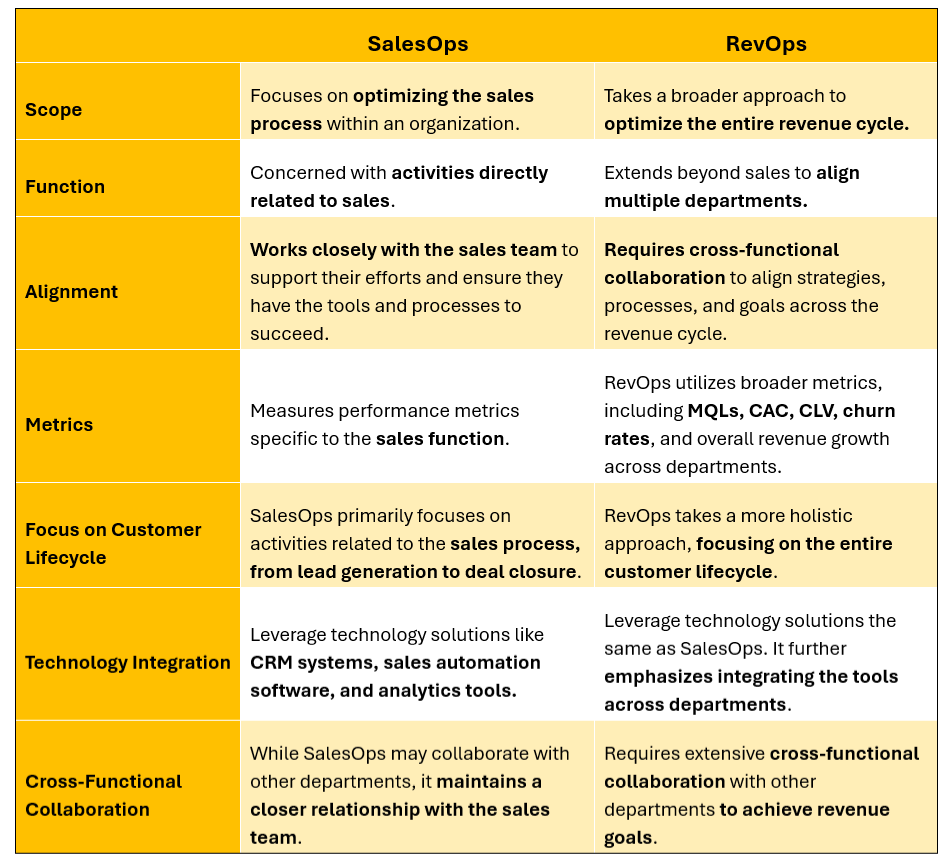In today’s dynamic business environment, maximizing revenue and optimizing operational efficiency are paramount for sustained success. Two key functions crucial in achieving these objectives are Sales Operations (SalesOps) and Revenue Operations (RevOps). While they share similarities in their goals, methodologies, and tools, they have distinct differences. In this blog post, we’ll delve into the nuances of SalesOps and RevOps, exploring their unique characteristics, roles, and benefits.

Understanding Sales Operations (SalesOps):
Sales Operations, often called SalesOps, is a specialized function within an organization dedicated to optimizing the sales process. Its primary objective is to support the sales team by streamlining operations, implementing efficient processes, and leveraging technology to drive revenue growth.
Key Components of SalesOps:
- Sales Strategy Development: Crafting effective sales strategies aligned with business goals and market trends.
- Sales Process Optimization: Continuously refining sales processes to enhance efficiency and effectiveness.
- Sales Forecasting: Utilizing data analysis and market insights to predict future sales performance.
- Territory Management: Strategically allocating sales resources and territories to maximize coverage and revenue potential.
- Sales Technology Implementation: Deploying and managing tools such as CRM systems, sales automation software, and analytics platforms to support sales efforts.
Understanding Revenue Operations (RevOps):
Revenue Operations, or RevOps, represents a more holistic approach to revenue generation that extends beyond the sales function. It involves aligning sales, marketing, customer success, and finance departments to optimize the entire revenue cycle, from lead generation to customer retention.
Key Components of RevOps:
- Cross-Functional Alignment: Breaking down silos between departments to create a unified revenue-generating strategy.
- Customer Lifecycle Management: To maximize lifetime value, focusing on the entire customer journey, from acquisition to retention.
- Data Integration and Analysis: Integrating data from various sources to gain insights into customer behavior, market trends, and revenue drivers.
- Process Optimization: Streamlining processes across departments to improve operational efficiency and customer experience.
- Technology Integration: Implementing integrated technology solutions that support the entire revenue cycle and enable seamless team collaboration.
Key differences between Sales Operations (SalesOps) and Revenue Operations (RevOps):

1. Scope:
- Sales Operations (SalesOps) focuses specifically on optimizing the sales process within an organization.
- Revenue Operations (RevOps) takes a broader approach, encompassing sales, marketing, customer success, and sometimes finance, to optimize the entire revenue cycle.
2. Function:
- SalesOps is primarily concerned with activities directly related to sales, such as sales strategy development, forecasting, territory management, and sales process optimization.
- RevOps extends beyond sales to align multiple departments, including sales, marketing, customer success
3. Alignment:
- Sales Operations typically works closely with the sales team to support their efforts and ensure they have the tools and processes to succeed.
- Revenue Operations requires cross-functional collaboration between sales, marketing, customer success, and finance departments to align strategies, processes, and goals across the entire revenue cycle.
4. Metrics:
- SalesOps measures performance metrics specific to the sales function, such as lead-to-opportunity conversion rates, win rates, sales cycle length, quota attainment, and revenue generated by sales reps or teams.
- RevOps utilizes a broader set of metrics that may include Marketing Qualified Leads (MQLs), Customer Acquisition Cost (CAC), Customer Lifetime Value (CLV), churn rates, and overall revenue growth across departments.
5. Focus on Customer Lifecycle:
- SalesOps primarily focuses on activities related to the sales process, from lead generation to deal closure.
- RevOps takes a more holistic approach, focusing on the entire customer lifecycle, from initial contact to post-sale support and retention, to maximize lifetime value and drive sustainable revenue growth.
6. Technology Integration:
- SalesOps and RevOps leverage technology solutions like CRM systems, sales automation software, and analytics tools. Still, RevOps emphasizes integrating these tools across departments to provide a unified view of the customer journey and revenue performance.
7. Cross-Functional Collaboration:
- While SalesOps may collaborate with other departments, such as marketing or finance, it typically maintains a closer relationship with the sales team.
- Revenue Operations requires extensive cross-functional collaboration between sales, marketing, customer success, and finance departments to align strategies, processes, and metrics to achieve revenue goals.
Key Similarities between Sales Operations (SalesOps) and Revenue Operations (RevOps):
- Alignment: Both SalesOps and RevOps aim to align processes, tools, and teams to drive revenue growth and improve operational efficiency.
- Data-driven: Both functions rely heavily on data analysis to identify trends, opportunities, and areas for improvement.
- Technology: SalesOps and RevOps utilize various technology solutions to streamline operations and enhance performance.
- Cross-functional Collaboration: While RevOps takes a more holistic approach, both functions require collaboration across departments to achieve their objectives.
Conclusion:
In summary, Sales Operations (SalesOps) and Revenue Operations (RevOps) might seem similar, but they have some big differences. SalesOps focuses just on sales, like making strategies and managing sales teams. RevOps, on the other hand, look at the whole picture, including sales, marketing, and even customer support, to ensure the company makes as much money as possible.
SalesOps mostly works with the sales team, while RevOps needs many different departments to work together. Both use technology and data, but RevOps uses them across the company. Understanding these differences helps businesses decide which approach is best for growing revenue, improving how they work, and making customers happier.
Unlock your business's full revenue potential!
Let Marmato Digital be your guide to seamless Revenue Operations (RevOps) transformation. With our expertise in aligning sales, marketing, and customer success strategies, we’ll help you streamline processes, maximize growth, and elevate the customer experience.
Take the first step towards revenue optimization today – Contact us and discover how Marmato Digital can drive your business to new heights!
Subscribe to Newsletter
Get our latest blogs directly to your inbox.

